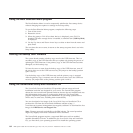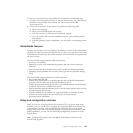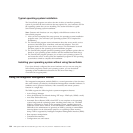Select this choice to view information about the server. When you make changes
through other choices in the Setup utility, some of those changes are reflected in
the system information; you cannot change settings directly in the system
information.
This choice is on the full Setup utility menu only.
– System Summary
Select this choice to view configuration information, including the ID, speed,
and cache size of the microprocessors; machine type and model of the server;
the serial number; the system UUID; and the amount of installed memory.
When you make configuration changes through other choices in the Setup
utility, the changes are reflected in the system summary; you cannot change
settings directly in the system summary.
– Product Data
Select this choice to view the system-board identifier and the revision level or
issue date of the server firmware, integrated management module, and
diagnostics code.
v System Settings
Select this choice to view or change the server component settings. This choice is
on the full Setup utility menu only.
– Adapters and UEFI Drivers
Select this choice to view information about the adapters and device drivers
in the server that are compliant with EFI 1.10 and UEFI 2.0.
– Processors
Select this choice to view or change the processor settings.
– Memory
Select this choice to view or change the memory settings. To configure
memory mirroring, select System Settings → Memory → Memory Mirroring
Mode → Mirrored.
– Devices and I/O Ports
Select this choice to view or change assignments for devices and
input/output (I/O) ports. You can configure the serial ports; configure remote
console redirection; enable or disable integrated Ethernet controllers, the
SAS/SATA controller, SATA optical drive channels, and PCI slots; and view
the system Ethernet MAC addresses. If you disable a device, it cannot be
configured, and the operating system will not be able to detect it (this is
equivalent to disconnecting the device).
– Power
Select this choice to view or change power settings.
- Active Energy Manager
Select this choice to enable or disable power capping. If you enable power
capping, the Active Energy Manager program will limit the maximum
power that is consumed by the server.
- Power Restore Policy
Select this choice to determine the mode of operation to which the server
will be restored after a power outage occurs. You can select Always on,
Always off,orRestore to restore the server the state it was in at the time
of the power outage.
– Operating Modes
Chapter 3. Configuring the server 97


















